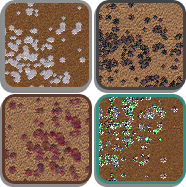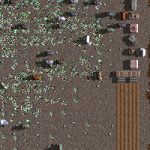Mines and deposits: Difference between revisions
No edit summary |
No edit summary |
||
| Line 1: | Line 1: | ||
[[File:deposit_preview.png|right]]'''Mines''' are types of [[extraction]] [[building]]s that involve extracting minerals from the [[world]]. All mines have two [[components]], the required [[storage]] and the optional auxiliary parts. Though the auxiliaries are not required to finish the mine, they will increase the production speed of the resources they're mining. The higher the percentage of | [[File:deposit_preview.png|right]]'''Mines''' are types of [[extraction]] [[building]]s that involve extracting minerals from the [[world]]. All mines have two [[components]], the required [[storage]] and the optional auxiliary parts. Though the auxiliaries are not required to finish the mine, they will increase the production speed of the [[resources]] they're mining. The higher the percentage of a deposit in a tile, the more resources that can be mined from it. Additionally, the larger the mine, the more [[workforce|employees]] that can be assigned to it. | ||
'''Deposits''' are areas of the [[world]] where natural | '''Deposits''' are areas of the [[world]] where natural resources can be found and [[Mine|mined]]. There are six resources that can be found in deposits: [[stone]], [[coal]], [[clay]], [[ore]], [[gems]] and [[sithilon ore]]. Each deposit can only be mined by a corresponding, matching type of mine built over them. And even though different mines need to be used, they all function exactly the same. | ||
When starting a new game, the player will be able to see the percentage of deposits in a chosen area. It is wise to try to choose an area with every type of deposit, or at the very least, as many as possible and/or the most important and frequently used ones, such as stone, coal or ore. Each deposit has a different level of how frequent they will appear in a world. Gem deposits are rare, while sithilon ore deposits are even rarer. | When starting a new game, the player will be able to see the percentage of deposits in a chosen area. It is wise to try to choose an area with every type of deposit, or at the very least, as many as possible and/or the most important and frequently used ones, such as stone, coal or ore. Each deposit has a different level of how frequent they will appear in a world. Gem deposits are rare, while sithilon ore deposits are even rarer. | ||
Revision as of 00:48, 6 August 2021

Mines are types of extraction buildings that involve extracting minerals from the world. All mines have two components, the required storage and the optional auxiliary parts. Though the auxiliaries are not required to finish the mine, they will increase the production speed of the resources they're mining. The higher the percentage of a deposit in a tile, the more resources that can be mined from it. Additionally, the larger the mine, the more employees that can be assigned to it.
Deposits are areas of the world where natural resources can be found and mined. There are six resources that can be found in deposits: stone, coal, clay, ore, gems and sithilon ore. Each deposit can only be mined by a corresponding, matching type of mine built over them. And even though different mines need to be used, they all function exactly the same.
When starting a new game, the player will be able to see the percentage of deposits in a chosen area. It is wise to try to choose an area with every type of deposit, or at the very least, as many as possible and/or the most important and frequently used ones, such as stone, coal or ore. Each deposit has a different level of how frequent they will appear in a world. Gem deposits are rare, while sithilon ore deposits are even rarer.
Starting a new game and finding deposits

As mentioned before, when choosing a location for your settlement's capital, a window will appear showing the information of the area the mouse is hovering over, showing the percentage of each type of deposit there. It is very hard to get a decent number of every single deposit in one location, so if this can't be found, the player will need to settle for the closest thing to this.
Clay deposits increase near rivers, while the other five are more frequent near mountains, and less in forested areas. This makes it very hard to find a location with both much-needed wood and all deposit types.
Placing mines

Mines are placed like any other building. When placing a mine on a matching deposit, the player must click and drag over an area with deposits. Mines must encompass both deposit and non-deposit tiles. The reason for this is while the mines must be obviously placed over deposits the player wants to mine, there must be extra space for the mine's components, being the required storage and optional auxiliaries (which speeds up production).
As one would expect, at least one tile of a matching deposit must be encompassed in the selection box for the mine's placement to be valid. Though mines have their own storage, they must eventually be moved to a warehouse or export depot (if the player wishes to trade away the resource). If a mine's storage is full, production will cease. Though not required, it is advised to build a warehouse near a mine if any other existing one is too far away. This is to ensure that citizens won't have to walk too far away just to store a mine's contents.
During the early stages of a game, getting the most out of your mines can be tricky. This is because the player will most likely not have any metal when starting out, yet metal is needed to build the auxiliaries of a mine, boosting its efficiency and production speed. This can be rectified in two ways: simply building an ore mine without auxiliaries, then (slowly) mining as much ore as possible and smelting it, then later using the smelted ore/metal to build auxiliaries, with the second way is to simply trade for metal.
The bigger the mine, the more employees can be hired there.
Importance of each deposit
- Stone deposits - Stone is one of the most frequently used resources next to wood. Countless buildings and structures require stone. Note that stone buildings decay slower than wooden ones, but faster than ones made of cut stone.
- Coal deposits - Coal is needed to fuel many things for many buildings, such as ovens in canteens and furnaces in metal smelters.
- Clay deposits - Though not as frequently used as the other resources, clay is needed to make pottery, which is used to make drinks and is needed for some building components.
- Ore deposits - Ore is the raw form of metal, which is created by - as mentioned before - being smelted in metal smelters. Its use becomes necessary in the mid-to-late stages of the game, being used in many buildings and components, much like wood and stone.
- Gem deposits - A very rare deposit. Gems are needed to make jewelry, which are lavish luxuries for citizens that will greatly boost their happiness when wearing it. Jewelry is the highest priced resource in the game, also making it a fantastic trading good. It's not used for any buildings, except the court.
- Sithilon ore deposits - The rarest deposit in the game. Sithilon ore is the second-highest value resource in the game. It has no uses on its own, and can't be smelted like standard ore, but accumulates high denari for trading, making it its only true helpful use.